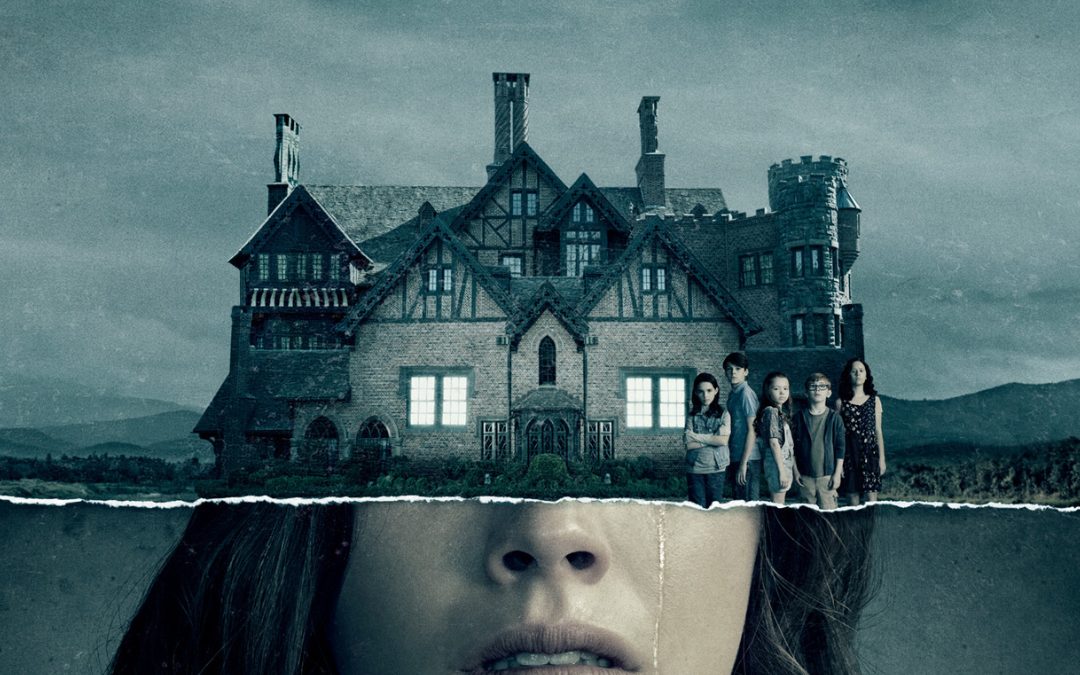When great literary works are adapted for the screen, it’s common to hear talk of new versions ‘staying true to the spirit’. We stayed true to the spirit, creatives say with a thoughtful nod. Sure, we changed the odd detail—tweaking the lead from a fifty-year-old shoe salesman to a twenty-year-old acrobat and setting it in Redondo Beach instead of Bromley—but the spirit? That we stuck to like glue.
Talk of spirits is apt when discussing one of the finest ghost stories ever written—Shirley Jackson’s 1959 The Haunting Of Hill House. Horror director Mike Flanagan (Oculus, Hush, Absentia) has made a ten-part Netflix series from Jackson’s novel, giving its two-hundred and fifty-pages more screen time than either previous feature film adaptation—the celebrated one from 1963 or the execrable one from 1999, which swapped Jackson’s rich psychological subtext for gurning wall-monsters and all the atmosphere of a cardboard box.
Flanagan’s adaptation works in every way the nineties film didn’t. It’s atmospheric, peppered with real scares, and the considerable changes it makes to the source material aren’t sensationalist, but sympathetic.
Without slavishly following its plot or characters, Flanagan has infused his series with Jackson’s original. There are quotes and details from the novel woven throughout, respectful homages paid while, respectfully, making something new out of it.
Flanagan’s version is no adaptation, it really is a reimagining. Character, plot and period have all been changed, but Jackson’s premise of a haunted house whose torture isn’t arbitrary, but feeds on deeply personal psychological torment, has been retained and expanded.
The Netflix series gives us a Hill House for our psychotherapy age. Trauma is its theme. How are family relationships affected by traumatic experiences? What coping mechanisms do people install to repress them? And what needs to happen to move forward and ultimately, heal?
The action takes place in two time frames, the 1980s and the modern day. The Crain family—father Hugh, mother Olivia, and children Steven, Shirley, Theodora, and twins Nel and Luke—spend a summer at Hill House that, as one might predict, changes everything. The story flips back and forth between the Crains’ lives as children and as adults, setting and answering questions about what happened in that fateful place, and exploring the psychological aftermath.
The chronology is well handled. The first five episodes are each devoted to a particular sibling’s story, showing how they intersect, and eventually adding up to a full family portrait. Episodes move fluently between formative childhood experiences and the resulting adult behaviour. Timelines are chopped up, and the reliability of the different narratives we’re seeing is often under question. It’s a revealing storytelling technique that allows, more than once, for a little heartbreak.
Broken things, broken people are this series’ focus. Netflix’s The Haunting Of Hill House is a character-based horror. It’s interested in how guilt and secrets, grief and resentment affect people and their relationships.
The scares, as you’d imagine from the director of Oculus, are excellent. Unlike the 1999 film adaptation, Flanagan and co. never show too much, and never do everything at once. There are jump scares, and creeping moments, unnerving revelations, and a few truly horrible images. None of it though, feels gratuitous or weightless. The horror elements are manifestations of character pain, not the sole cause of it.
Faithfully rendered is the titular setting – Hill House, not sane. Conjuring up on screen an environment that properly evokes the deranged, suffocating location Shirley Jackson describes, with its unfathomable geography, is almost impossible, but this is a solid attempt. The exterior, with its clash of architectural styles and oppressive weight, feels mad. The house’s foreboding nature makes one plot change—the family aren’t staying at Hill House as part of a supernatural research experiment, they’re renovating it over a summer to flip for profit—slightly suspect. Even a Rightmove-of-the-damned would balk at listing this place.
Inside, the TV series struggles to distinguish the setting from the established and genre-familiar. We’ve seen grotesque marble statuary, rickety staircases and dark wood panelling in other haunted houses. The work invested in character interiors pays off more. One ‘bottle’ episode in which simmering personal tensions boil over is an example of how the show is, at heart, a family drama accented cleverly through horror.
Flanagan’s Netflix series has done what adaptations always should. It’s created something new and cohesive out of the original while, yes—forgive the cliche—staying true to its spirit.
The Haunting Of Hill House arrives on Netflix on Friday the 12thof October.

